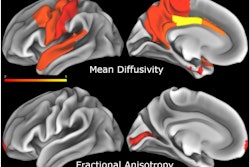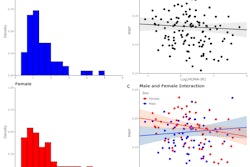CHICAGO -- Characterizing an individual's type of body fat using body MRI can help predict Alzheimer's disease risk up to 20 years before symptoms manifest, according to research results presented December 2 at the RSNA meeting.
A team led by Mahsa Dolatshahi, MD, of Mallinckrodt Institute of Radiology (MIR) at Washington University School of Medicine in St. Louis, MO, found that obesity, higher visceral fat, insulin resistance, body mass index, and subcutaneous fat are associated with higher whole-brain amyloid levels in midlife.
 Mahsa Dolatshahi, MD.
Mahsa Dolatshahi, MD.
"[Our study] highlights the importance of anatomical characterization of body fat for Alzheimer's risk, where obesity-related amyloid pathology is fully explained by visceral fat," Dolatshahi and colleagues explained.
The Alzheimer's Association estimates that almost seven million Americans 65 years of age and older live with the disease and that this number could grow to 13 million by 2050, the authors noted. They conducted a study that investigated any links between "modifiable lifestyle-related factors" such as obesity, body fat distribution and metabolic aspects, and Alzheimer's disease.
The research included 62 cognitively healthy individuals (average age, 50) who underwent a brain PET scan, body MRI, and metabolic assessment. The team measured participants' insulin resistance via the Homeostatic Model Assessment for Insulin Resistance (HOMAIR) and assessed associations between centiloid measures (used to assess amyloid deposits in PET brain scans) and body mass index, HOMAIR, MRI-derived abdominal visceral and subcutaneous adipose tissue, liver proton-density fat fraction, and thigh fat-to-muscle ratio.
 Comparison of cerebral blood flow in 65 cognitively normal midlife individuals showed that individuals with obesity and high visceral adipose tissue have reduced blood flow in the temporal and parietal regions of the brain. Images courtesy of the RSNA.
Comparison of cerebral blood flow in 65 cognitively normal midlife individuals showed that individuals with obesity and high visceral adipose tissue have reduced blood flow in the temporal and parietal regions of the brain. Images courtesy of the RSNA.
Dolatshahi and colleagues reported that higher levels of visceral fat were associated with increased amyloid, accounting for 77% of the effect of high body mass index on amyloid accumulation. The research also showed that higher insulin resistance and lower levels of high-density lipoprotein (HDL) were associated with high amyloid in the brain.
The study results underscore the importance of decreasing visceral fat to avoid Alzheimer's, noted senior author Cyrus Raji, MD, PhD, also of Mallinckrodt Institute of Radiology.
"A key implication of our work is that managing Alzheimer's risk in obesity will need to involve targeting the related metabolic and lipid issues that often arise with higher body fat," Raji said in the RSNA statement.



















